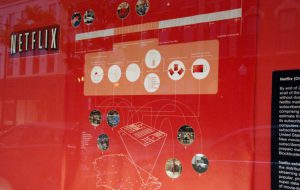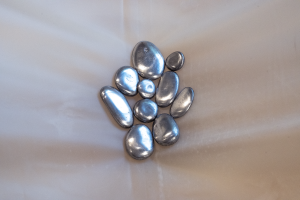Despite the frenzy of activity at Art Chicago this past weekend, I was fortunate to be able to interview Rob Lentz, the Program Director of Project Onward, an organization housed under the Chicago Cultural Center which provides studio space for and promotes the professional growth of artists with mental or developmental disabilities. They take a unique approach as a community based organization working with artists who have disabilities, and here Rob Lentz illuminates the mission of Project Onward and their impact on Chicago’s cultural landscape.

Jennifer Nalbantyan: How long have you been part of Project Onward?
Rob Lentz: I’ve been with Project Onward since when we started in 2004 and had been involved before that with Gallery 37—the program for youth also housed under the Department of Cultural Affairs.
JN: What criteria do you use to find the artists who work under Project Onward?
RL: Well, when we first started the program, I had been with Gallery 37 for quite a few years and had gotten to know and become really interested in artists who had disabilities—autism in particular—and so George Zuniga and Michael Smith were two of the artists that I became really interested in. Around about 2003 and 2004, they were both reaching an age where they weren’t able to stay with Gallery 37 and there were some other artists who we felt had potential commercially and were really viable as artists, but we didn’t know what was going to happen to them after they aged out of Gallery 37, because after that point, the services just kind of get cut off and you’re on your own.
So what we decided to do was make a place for them—make a studio for them—that would allow them to be a little more independent and kind of take the experience that they had gotten and skills with art making and take it to the next level. We originally started in 2004 as Project Onward but still under the umbrella of Gallery 37.
JN: Was Gallery 37 for kids with developmental disabilities in particular as well?
RL: No, it was an overall high school program. But they were looking at the Chicago Public Schools model of inclusion, so they did have a subset of their apprentices who had disabilities. They did a really good job of working with those students and we knew a lot about them [the students] and got to know their families and that was part of the inspiration for starting Project Onward—because we really knew who the artists were and what their challenges were and also what they were capable of doing.
Later, when we expanded, we became independent of Gallery 37 but still operate under the Department of Cultural Affairs.

JN: Would you say that most of these artists come into Project Onward expecting professional development in order to pursue a professional career in art or are some of them simply using it as an outlet for personal reasons?
RL: Well, that’s what we’re hoping to offer, is professional development. Most programs that are community based who work with this population tend to be part of art therapy programs or part of a social service agency, so it’s more of a recreational or therapeutic approach, but we’re really all about our artists being professional. We want them to create a body of work that continues to evolve and we want them to continue to grow as artists and not do the same thing over and over again. What we’re really hoping is that each artist will bring to the studio their own vision and their style—they’re full-fledged artists already, so we’re not teaching them how to do their work. We call ourselves facilitators and we provide a work space and the materials.
JN: So does that mean there are no classes and structured instruction, but instead open studio?
RL: Yeah it’s open studio. So basically what we’ll do is we work with each artist to come up with a plan—how much time they’re going to spend in the studio per week, we get a space for them to work in, we figure out what their media are going to be and then we just kind of let them do what they would do naturally. Some artists need more help, especially to stay focused and to keep on task; other artists are completely self-directed and we just let them do what they’re going to do. With those kinds of artists, we have higher standards of what their output is, so when they’re finished with their work, we’ll have critiques and we’re able to have a dialogue with certain artists that is at a much high level than with others. We really adapt our approach to each individual.
JN: How long is the program—is there a set duration for each artist?
RL: There’s not. We feel like if an artist is strong enough to be in the program in the first place, then they’re able to stay indefinitely as long as they continue to be productive and they don’t have any major changes in their life that would disrupt their art making and that they’re continuing to grow and interested in growing. Most of the artists have been with us for years and we hope they’ll stay with us because they’re really—well, art is something that they have to do. It’s not recreational for them.

JN: How many artists do you have in the program right now?
RL: Currently, about 33 artists and that’s a lot—that’s kind of our maximum. Every year we have a little turnover and we do like to bring in new artists, but our core group of artists is a pretty stable group. And that’s kind of a rare thing to be able to do—to have a relationship with an artist over years. It’s very gratifying.
JN: What is the exhibition schedule and does it all take place at your space in the Cultural Center?
RL: We have rotating exhibits at our gallery at the Cultural Center outside of our studio. Every eight weeks we do a new show. They tend to be either solo shows where we feature a particular artist who has developed a body of work that’s ready to be exhibited, or we’ll do thematic shows. The one we have up right now is about autism—and that’s for April’s Autism Awareness Month. Next month we’ll be putting up a show that’s all landscapes which we’ve wanted to do for a while.
JN: How did you select the pieces that are in this exhibition for Art Chicago?
RL: We kind of looked at the artists who are really prolific, who are making a lot of work because, you know, when you make a lot of work, you make a lot of progress and you tend to take more risks and push things a little bit further. But it also tends to be a more recognizable style. Some of our artists have a completely unique style that they’re going for and with a show like this where there are so many galleries and artists in one place, we really tried to make our booth stand out and be colorful and bold.
JN: Do you think that your placement within the Cultural Center has had an impact on Project Onward?
RL: Yeah, the public visibility has been amazing, and I think it’s good for the Cultural Center too because it sends the signal that culture is literally for everybody and it’s not exclusive. It’s free and people come from all over the world. People tend to stumble upon us and are really amazed at what’s going on. We’ve had nothing but great support.

JN: I read on the website that there are numerous collectors and galleries who collect pieces from artists with Project Onward. How do you promote the work commercially?
RL: One of the things that we’ve always done from the very beginning is to get the work out of the studio so that people can see it. It’s only until fairly recently that we’ve had our very own gallery to show the work, so we’ve always been really aggressive about partnering with commercial galleries and doing art fairs like this, the Intuit show, and we put our work up in restaurants and cafes. We’re going to be doing a big show at Caffé Baci this summer and several of our artists will be in a show at Judy Saslow Gallery in the summer—she’s been very supportive.
JN: Lastly, how do you feel about the label “Outsider Art”? Do you think that’s a term that fits in with what you’re doing at Project Onward?
RL: Well, in a way it is a convenient label because it does address that issue of people who are marginalized, and it’s not that we want them to be outsiders or on the margins, but just the fact that our artists have disabilities puts them at a remove from the mainstream, whether its art or just culture at large. And that’s why I think it’s so important that we have a place at the Cultural Center, because the Cultural Center is about just that—culture—and it’s not about divvying it up into categories in which certain people are excluded.
But also, we have a lot of different audiences and a big chunk of our audience is the outsider art market, because a lot of our artists just fit the mold stylistically and they’re almost all self-taught; very few of our artists fit any huge conventions. But overall, there is a lot of diverse work being made and many of our artists overlap with diverse styles and audiences.
Check out Project Onward‘s next event, Portrait Slam!, on Saturday, May 28 from 10-5 pm at the Chicago Cultural Center.



